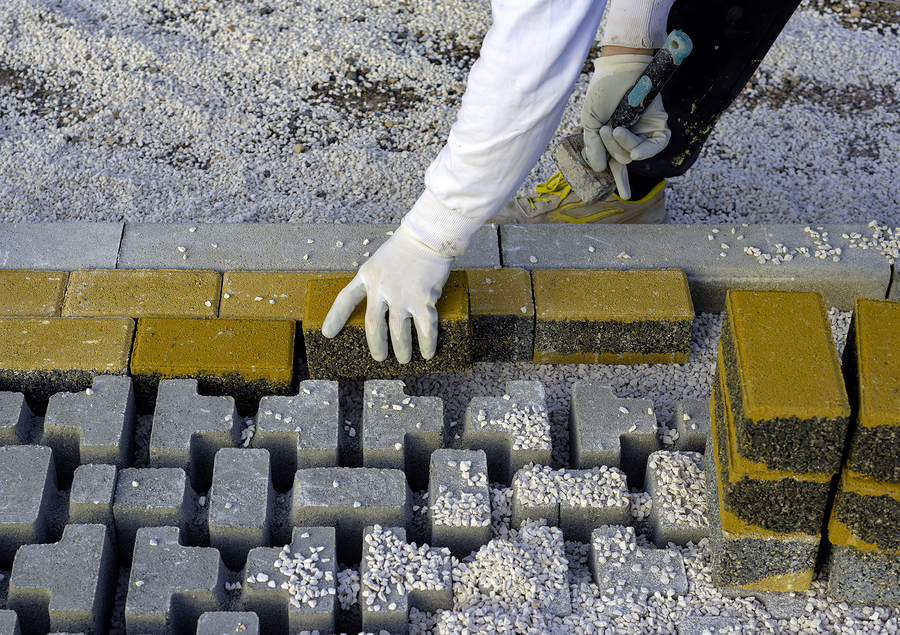It is wise to take some time and research the process of installing and managing interlocking stone pavements before boldly attempting to do it all on your own. Successfully undertaking a project like this requires extensive knowledge, experience, and access to proper resources and equipment. Many “do-it-yourself” (DIY) enthusiasts have started a stone pavement installation job only to find out a few hours in that they are in over their heads. This leaves thousands of homeowners stuck with an incomplete pavement project, and no idea what to do next.
Needless to say, it is strongly advised to outsource professional paving contractors for accurate and proficient stone interlocking pavement installation services, done right the first time around. Continue reading to learn more about interlocking pavement installation, and what you need to know before choosing a DIY approach.

Interlocking Pavement Basics
One easy way to imagine and describe interlocking paving stones is to compare them to a jigsaw puzzle. The way these stones fit together is very similar to a puzzle. They are cut at a manufacturing company in specific grids and shapes, and then pieced together to fit or cover an intended surface. Interlocking stones are not to be confused with tile, which requires a flat non-flexible surface, and motor for securing. Interlock paving requires a separate type of bonding material, often times sand; and also requires a different before and after process. Minor to major preconstruction work is needed to prepare the surface for the stone, and the stones must then be fitted together through the use of friction and manual labor.
As you can see, it is much more than just laying stone in dirt and calling it a day! For a proper interlock paving job, and a lifetime of usage, the process from start to finish must be correct. This kind of pavement can be a fantastic and inexpensive way to add value to your home and instantly increase curb appeal.
Here is a generic timeline of what to expect with an interlocking pavement installation project:
First Step: Demolition
The surface area that is to be paved will need to be demolished and cleared. It usually requires a jackhammer, small bulldozer or bobcat, and other construction equipment and tools to complete this step. Existing walkway, sidewalk, concrete, grass, deck, patio tile, and more are broken apart and thrown away.
Second Step: Surface Leveling
The soil beneath whatever was excavated needs to be cleared of debris, flattened, and leveled to an even and apposite depth. Deeper excavation of soil and an added base or foundation is required for surface areas that are intended to hold extra weight; like cars, trucks, and recreation vehicles. Areas like driveways, garages, and more will need this extra depth. This is one of the most time-consuming and labor-intensive steps in the entire process; even WITH professional equipment. For those who wish to do this step on their own with just shovels and wheelbarrows, they can expect this part to cause a load of stress, frustration, and lots of time.
Third Step: Dirt Removal and Haul-Away
Once the level is properly surfaced, there will be an excess of soil, dirt, and debris leftover. A professional paving service provides a dump truck to haul away unused or excavated soil. For someone who is doing this on their own, they will have trouble finding somewhere to put all this dirt. It is costly to hire or rent a truck that will hold organic material as well.
Step Four: Installation
A woven geo-textile fabric is installed over the excavated area, but under aggregate rock foundations, to restrict the foundation base rock from sinking into the clay soil. Because it is permeable, it allows water to flow through without jeopardizing the structural integrity of the pavement and foundation. Once this is installed, a CLASS II base rock foundation and bedding sand are installed on top. It is imperative to use the proper rock base material for an accurate and effective interlocking stone pavement job. If installed properly, little or no maintenance is required over the following years. The last part is arranging and fitting the stones to form a beautiful pavement. This part truly requires the skill and expertise of a professional pavement and road construction company.
ACI Asphalt and Concrete Inc.
Call ACI Asphalt and Concrete at 317-549-1833 for commercial and industrial paving services in Indianapolis, Indiana. Our licensed and qualified paving contractors provide several Indianapolis asphalt and concrete paving services, including pavement repair, sealcoating, road work, commercial paving, industrial paving, winter cold patching, and more. We are the industry veterans to trust for skilled craftsmanship and competitive prices! Request a free estimate, today.


